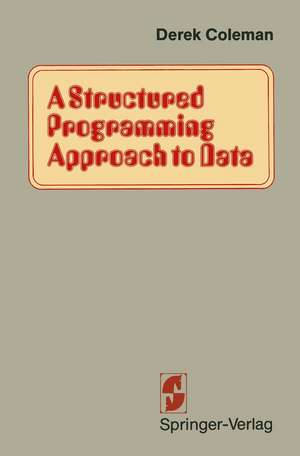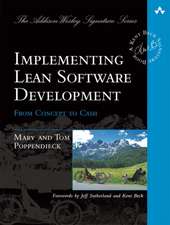A Structured Programming Approach to Data
Autor COLEMANen Limba Engleză Paperback – 27 aug 2012
Preț: 329.44 lei
Preț vechi: 411.80 lei
-20% Nou
Puncte Express: 494
Preț estimativ în valută:
63.04€ • 67.41$ • 52.56£
63.04€ • 67.41$ • 52.56£
Carte tipărită la comandă
Livrare economică 18 aprilie-02 mai
Preluare comenzi: 021 569.72.76
Specificații
ISBN-13: 9781468479874
ISBN-10: 1468479873
Pagini: 236
Ilustrații: XII, 222 p. 1 illus.
Dimensiuni: 155 x 235 x 12 mm
Greutate: 0.34 kg
Ediția:1979
Editura: Springer
Colecția Springer
Locul publicării:New York, NY, United States
ISBN-10: 1468479873
Pagini: 236
Ilustrații: XII, 222 p. 1 illus.
Dimensiuni: 155 x 235 x 12 mm
Greutate: 0.34 kg
Ediția:1979
Editura: Springer
Colecția Springer
Locul publicării:New York, NY, United States
Public țintă
Professional/practitionerCuprins
1. An Overview of Program Design.- 1.1 Introduction — The Software Crisis.- 1.2 Objectives of Program Design.- 1.3 The Heart of the Problem.- 1.4 Stepwise Refinement.- 1.5 What Do We Mean When We Say a Program ‘Works’?.- 1.6 Summary.- 1.7 Bibliographical Notes.- 2. Program Design Notation.- 2.1 An Abstract Programming Language.- 2.2 Structuring Control.- 2.3 Structuring Data.- 2.4 What is a Data Structure?.- 2.5 Unstructured Data Types.- 2.6 Implementation of Unstructured Types.- 2.7 Summary.- 2.8 Bibliographical Notes.- 3. Arrays.- 3.1 Array Structures.- 3.2 Arrays and Functions.- 3.3 Implementation of Arrays.- 3.4 Summary.- 3.5 Bibliographical Notes.- 4. Simple Data Structuring.- 4.1 Record Types.- 4.2 Implementation of Record Types.- 4.3 Use of Structured Types.- 4.4 Variant Types.- 4.5 Implementation of Variant Types.- 4.6 Summary.- 4.7 Bibliographical Notes.- 5. On Program Design.- 5.1 Stepwise Refinement of Programs.- 5.2 Two Examples.- 5.3 Summary.- 5.4 Bibliographical Notes.- Exercises 1.- 6. Set Structures.- 7. The Class Construct.- 8. Dynamic Data Structures.- 9. Sequences.- Exercises 2.- 10. Simple Searching Techniques.- 11. Hashing Techniques.- 12. Recursion and Recursive Algorithms.- 13. Binary Search Trees.- Exercises 3.- 14. Designing Programs From Data Structures.- Exercises 4.- References.















